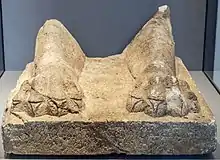Phoenician Sphinx inscription
The Phoenician Sphinx inscription, also known as the Abdadoni inscription is an inscription found at Umm al-Amad, Lebanon.[1]

The inscription is written on the socle of a statue of a couching sphinx, with only the feet and ankles still attached. The body of the sphinx was found lying next to it, but the head was not found. The inscription stated that the statue was dedicated to Milk'ashtart El - Hammon.
It was found to the right of an entrance to one of the buildings on the east side, at the edge of the street. It was one of a number of sphinx fragments found at the site.[2] It is thought that the entrance to the temple complex was flanked by two such sphinx statues.[3]
It is currently in the National Museum of Beirut.
It was first published in 1962 by Maurice Dunand and Raymond Duru, although likely discovered previously.
Bibliography
- Dunand, M.; Duru, R. (1962). Oumm el-'Amed: une ville de l'époque hellénistique aux échelles de Tyr ... (in French). Librairie d'Amérique et d'Orient. pp. M. 435, Plate XXX.
- Krahmalkov, Charles. “NOTES ON THE INSCRIPTION OF ’BD’DNY FROM UMM EL-’AMED.” Rivista Degli Studi Orientali 46, no. 1/2 (1971): 33–37. http://www.jstor.org/stable/41880192.
- A. Caquot. "Le dieu Mikastart et les inscriptions d'Oum el-Ahmed", Semitica, XV, 1965
References
- Dunand & Duru 1962, pp. 48, M. 435, Plate XXX"A droite de cette entrée, en bordure de la rue, sur un socle de section verticale légèrement trapézoidale, était encastrée la base d’une statue aux pieds brisés á la hauteur des chevilles… Le corps gisait á côté, décapité… Une inscription sur la face du socle nous apprend qu'elle était consacrée à Milk'ashtart El - Hammon."
- Dunand & Duru 1962"Deux autres fragments de sphinx , M 13 et M 14 , provenant du petit dépôt abandonné près du temple de Milk'ashtart , attestent l'existence d'un deuxième sphinx à gorgerin et d'un troisième accroupi avec la queue enroulée autour du jarret droit, l'un et l'autre également campés sur une plinthe.... M 13.= Protome de sphinx accroupi sur une plinthe. Le poitrail s'orne d'un large collier à rosaces et lancettes . Haut . : 0. 40. (Pl . XXXVIII , 3).... M 14.- Partie postérieure d'un sphinx accroupi sur une plinthe , avec queue enroulée autour du jarret droit et terminée par une...."
- Mellink, Machteld J. Journal of Biblical Literature 84, no. 3 (1965): 326–28. https://doi.org/10.2307/3265046. "The form of the temple and its cult arrangements are of no specific aid in explaining the nature of the deity, except that the east side entrance to the complex probably was flanked by two statues of male votaries (of Egyptianizing type) set on pedestals with dedicatory inscriptions (pp. 48. 184 f., pls. 30 and 81, 3)."